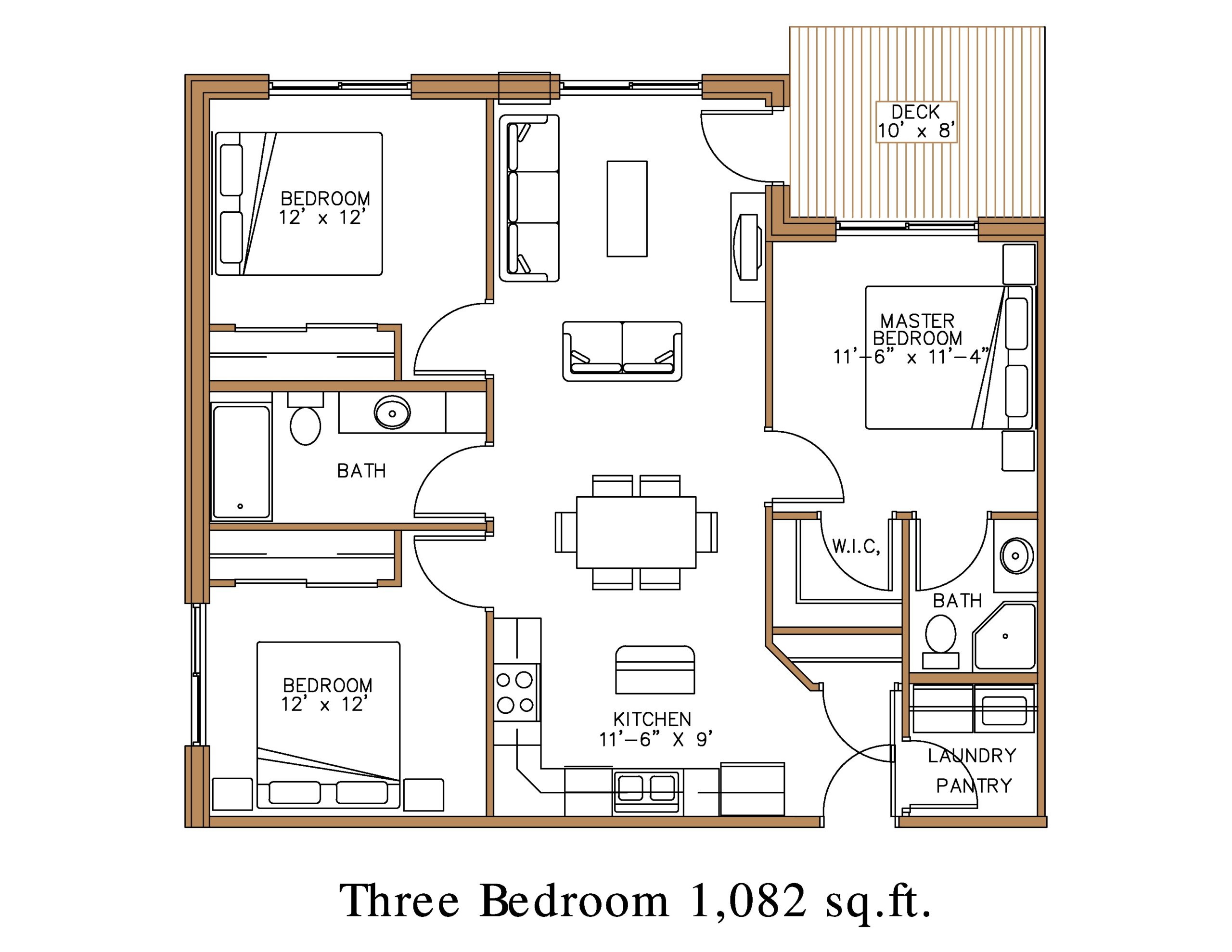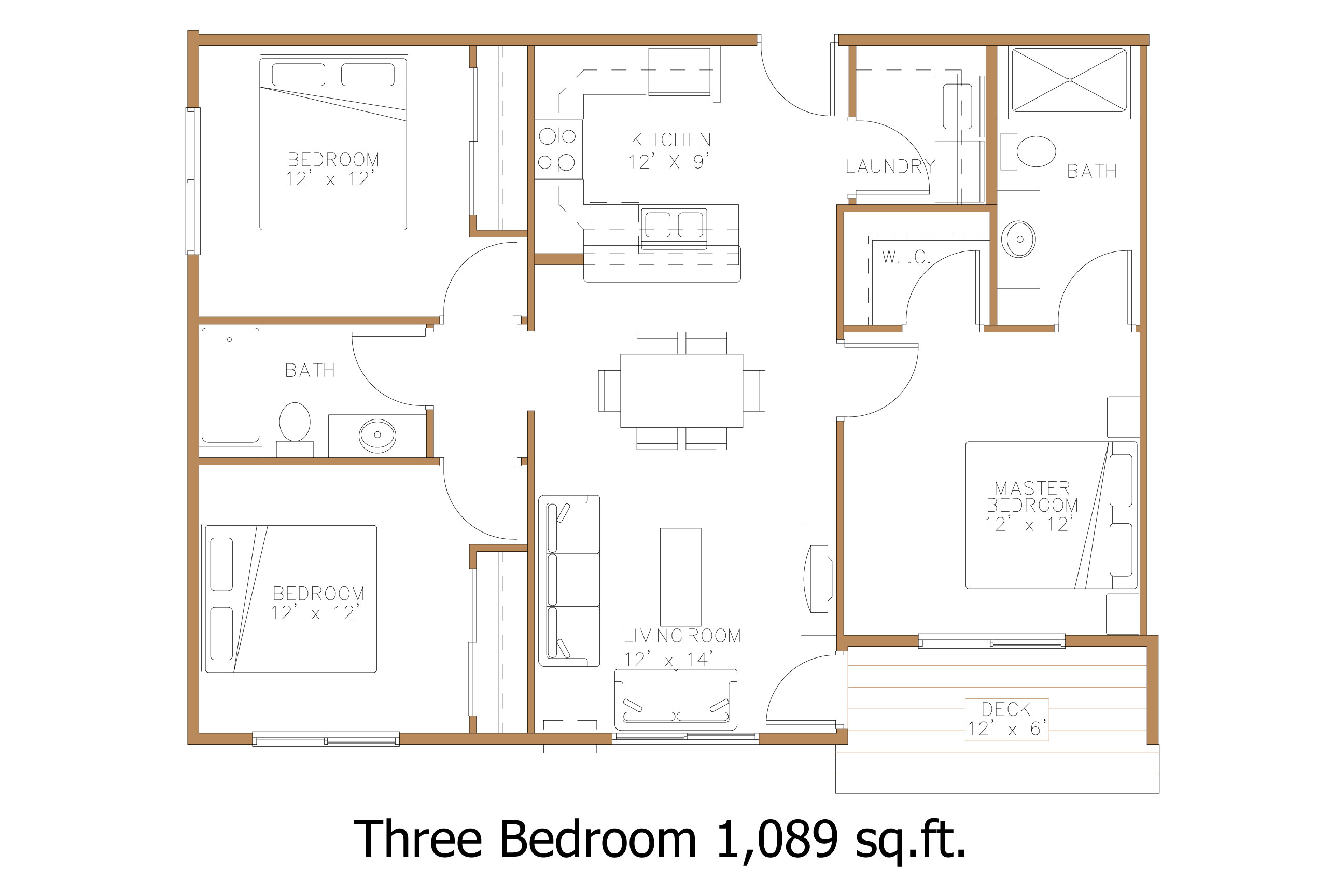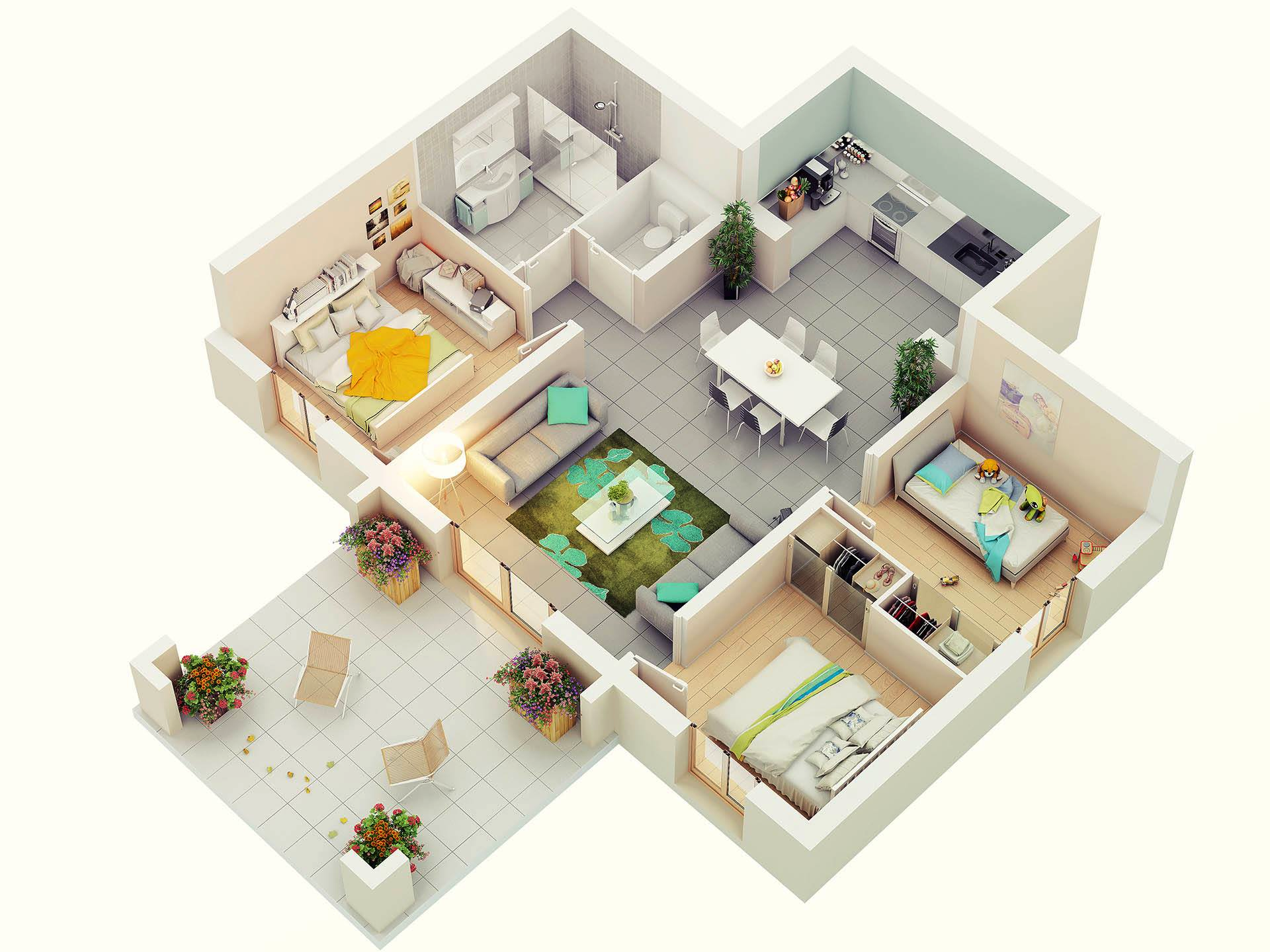Understanding Three Bedroom Plan Design Needs

The design of a three-bedroom home is a significant undertaking, as it requires careful consideration of various factors to ensure functionality, flow, and overall satisfaction for the inhabitants. This type of home caters to a diverse range of lifestyles and needs, making it crucial to understand the specific requirements that drive the design process.
Common Needs and Desires
The design of a three-bedroom home must address the common needs and desires of its inhabitants. These needs vary depending on the lifestyle of the occupants. For example, a family with young children will have different needs than a couple looking for a comfortable space to entertain guests. Some common needs and desires include:
- Privacy: Three bedrooms offer separate spaces for individuals to retreat and enjoy privacy. This is especially important for families with teenagers or guests who value their personal space.
- Functionality: A well-designed three-bedroom home prioritizes functionality, ensuring each room serves its intended purpose efficiently. This includes adequate storage space, efficient traffic flow, and designated areas for different activities.
- Flexibility: A three-bedroom home should offer flexibility to accommodate changing needs. For instance, a spare bedroom can be converted into a home office, a guest room, or a playroom as the family’s needs evolve.
- Aesthetics: The design should incorporate aesthetic elements that reflect the homeowners’ taste and preferences. This includes selecting colors, materials, and finishes that create a cohesive and visually appealing space.
Importance of Functionality and Flow
Functionality and flow are crucial aspects of a successful three-bedroom plan design. A well-designed home maximizes the use of space while ensuring smooth movement between rooms. This means:
- Efficient Traffic Flow: The design should minimize traffic bottlenecks and ensure easy access to all areas of the home. This includes strategically placing doorways, hallways, and stairs to facilitate smooth movement.
- Strategic Placement of Rooms: The location of bedrooms, bathrooms, and living areas should be carefully considered to ensure privacy, convenience, and functionality. For example, placing the master bedroom away from the children’s bedrooms can provide greater privacy.
- Maximizing Space: The design should optimize space utilization, minimizing wasted areas and maximizing storage solutions. This includes incorporating built-in shelves, closets, and other storage features.
Lifestyle Considerations
A three-bedroom home can accommodate various lifestyles, each with its unique set of requirements.
- Families with Children: For families with children, the design should prioritize safety, functionality, and play space. This includes creating designated areas for children’s activities, incorporating safety features like childproof locks, and providing adequate storage space for toys and belongings.
- Couples: Couples may prefer a more spacious and luxurious design, focusing on creating a comfortable and inviting environment for entertaining guests and enjoying their leisure time. The design should prioritize open floor plans, spacious living areas, and well-appointed kitchens.
- Empty Nesters: Empty nesters may desire a more minimalist and functional design, emphasizing simplicity, ease of maintenance, and accessibility. This includes incorporating features like single-story living, walk-in showers, and grab bars for safety and convenience.
- Home Offices: Many three-bedroom homes are designed with a dedicated home office space, allowing for a seamless transition between work and home life. The design should provide adequate lighting, ventilation, and storage for work-related items.
Exploring Three Bedroom Plan Layouts

The design of a three-bedroom home is a fascinating journey that involves careful consideration of layout, flow, and functionality. Understanding the different layout options available for bedrooms, living areas, and kitchens can significantly impact the overall livability and aesthetic appeal of your home.
Popular Three-Bedroom Floor Plan Layouts
Three-bedroom floor plans offer a wide array of options to suit diverse lifestyles and preferences. Common layouts include:
- Open-Concept Layout: This layout emphasizes open spaces, often merging the living room, dining room, and kitchen into a single, expansive area. This promotes a sense of spaciousness and encourages social interaction.
- Traditional Layout: This layout features distinct rooms with defined boundaries, such as separate living, dining, and kitchen areas. It offers greater privacy and allows for a more formal atmosphere.
- Split-Level Layout: This layout utilizes different levels within the home, often with the bedrooms situated on a different level from the living areas. This creates a sense of separation and allows for a more private retreat.
- L-Shaped Layout: This layout features a living area that extends into a hallway or corridor, often leading to the bedrooms. This layout can create a more intimate and cozy atmosphere.
Comparison of Bedroom, Living Area, and Kitchen Layouts, Three bedroom plan design
The arrangement of bedrooms, living areas, and kitchens significantly influences the functionality and flow of a three-bedroom home.
- Bedrooms:
- Master Suite: A master suite typically includes a spacious bedroom, a private bathroom, and often a walk-in closet. This layout offers a sanctuary for relaxation and privacy.
- Guest Bedrooms: Guest bedrooms are often smaller and designed to accommodate visitors. They may feature built-in storage or a shared bathroom.
- Children’s Bedrooms: Children’s bedrooms may be designed with playful themes or incorporate flexible storage solutions to accommodate their changing needs.
- Living Areas:
- Open-Concept Living: This layout offers a spacious and inviting environment for social gatherings and family activities.
- Formal Living Room: A traditional layout may include a separate formal living room, often used for special occasions or entertaining guests.
- Family Room: This room is typically designed for casual gatherings and family time, often located near the kitchen.
- Kitchens:
- Open Kitchen: An open kitchen seamlessly blends with the living and dining areas, promoting a sense of connection and flow.
- Closed Kitchen: A closed kitchen provides a separate space for cooking and meal preparation, offering greater privacy and noise control.
- Kitchen Island: A kitchen island serves as a focal point and provides additional workspace and seating.
Advantages and Disadvantages of Open-Concept and Traditional Layouts
Open-concept and traditional layouts offer distinct advantages and disadvantages that should be carefully considered.
- Open-Concept Layout:
- Advantages:
- Spaciousness: Open-concept layouts create a sense of openness and expansiveness.
- Social Interaction: They encourage interaction and connection among family members and guests.
- Natural Light: They allow for greater natural light penetration.
- Disadvantages:
- Lack of Privacy: The open design may limit privacy, particularly in bedrooms or bathrooms.
- Noise: Open spaces can amplify noise levels, making it challenging to create quiet zones.
- Limited Flexibility: The open layout may limit the flexibility to rearrange furniture or create distinct zones.
- Advantages:
- Traditional Layout:
- Advantages:
- Privacy: Traditional layouts offer greater privacy and separation between rooms.
- Noise Control: They provide better noise control, allowing for quiet zones within the home.
- Flexibility: They offer greater flexibility in terms of furniture arrangement and room utilization.
- Disadvantages:
- Limited Space: Traditional layouts can feel smaller and more confined.
- Limited Social Interaction: They can create a sense of separation and limit social interaction.
- Less Natural Light: The defined rooms may restrict natural light penetration.
- Advantages:
Designing a Three Bedroom Plan: Three Bedroom Plan Design

Designing a three-bedroom plan requires careful consideration of various factors to create a functional and aesthetically pleasing home. The layout, flow, and functionality of each room must be carefully planned to ensure a comfortable and harmonious living space.
Key Design Considerations
The key design considerations for a three-bedroom plan include:
- Space Allocation: Determining the size and layout of each room based on the needs of the occupants. This involves allocating sufficient space for bedrooms, bathrooms, living areas, kitchen, and other essential areas.
- Traffic Flow: Planning the flow of movement within the house, ensuring smooth transitions between rooms and avoiding bottlenecks or congested areas.
- Natural Light: Maximizing natural light by strategically placing windows and doors to create a bright and airy environment. This can improve the overall ambiance and energy efficiency of the home.
- Privacy: Ensuring adequate privacy for each bedroom and other personal spaces, while also maintaining a sense of openness and connection within the home.
- Storage Solutions: Incorporating ample storage space in each room to minimize clutter and maintain an organized environment. This includes built-in cabinets, closets, and other storage solutions.
- Accessibility: Considering the needs of all occupants, including those with mobility limitations, by incorporating features such as ramps, wider doorways, and accessible bathrooms.
Floor Plan Example
A three-bedroom home can be designed in various configurations, depending on the specific needs and preferences of the occupants. Here is a detailed floor plan example of a three-bedroom home with a focus on functionality and efficiency:
- Entryway: The entryway serves as a welcoming space and provides a transition from the outside to the interior. It can include a coat closet, shoe storage, and a small console table for keys and mail.
- Living Room: The living room is the central gathering space of the home, offering a comfortable area for relaxation and entertainment. It can feature a spacious seating arrangement, a television, and a fireplace for ambiance.
- Dining Room: The dining room provides a dedicated space for meals and gatherings. It can be open to the kitchen or have a separate entrance. A large dining table and comfortable chairs are essential for this space.
- Kitchen: The kitchen is the heart of the home, where meals are prepared and enjoyed. It should be equipped with essential appliances, ample counter space, and sufficient storage for kitchenware and food.
- Master Bedroom: The master bedroom offers a private sanctuary for relaxation and sleep. It can include a king-size bed, a walk-in closet, and an ensuite bathroom for added convenience.
- Bedroom 2: This bedroom can be used as a guest room, a home office, or a nursery, depending on the needs of the family. It can feature a queen-size bed, a desk, or a crib, respectively.
- Bedroom 3: This bedroom can be designed as a children’s room, a guest room, or a home office. It can include twin beds, a bunk bed, or a desk, depending on its intended use.
- Bathroom: The bathroom provides a space for personal hygiene and relaxation. It can include a shower, a bathtub, a toilet, and a vanity with a sink. Separate bathrooms for the master bedroom and other bedrooms can be included for added privacy.
Room Features and Functionalities
Each room in the home should be designed with specific features and functionalities to optimize its use and enhance the overall living experience:
- Bedrooms: Bedrooms should be designed for relaxation and sleep. They should be well-ventilated, have ample natural light, and provide adequate storage space for clothing and personal belongings. A comfortable bed, bedside tables, and a reading lamp are essential features for a restful sleep.
- Living Room: The living room should be a welcoming and comfortable space for relaxation and entertainment. It can include a spacious seating arrangement, a television, a fireplace, and bookshelves for personal belongings. The layout should facilitate conversation and allow for different seating arrangements.
- Dining Room: The dining room should be a dedicated space for meals and gatherings. A large dining table and comfortable chairs are essential for this space. Natural light, a pleasant ambiance, and ample space for movement are crucial for creating a welcoming dining experience.
- Kitchen: The kitchen should be designed for efficient meal preparation and enjoyment. It should be equipped with essential appliances, ample counter space, and sufficient storage for kitchenware and food. A well-planned layout, good lighting, and ergonomic features are essential for creating a functional and enjoyable kitchen space.
- Bathroom: The bathroom should provide a space for personal hygiene and relaxation. It can include a shower, a bathtub, a toilet, and a vanity with a sink. Adequate lighting, ventilation, and storage space are crucial for a comfortable and functional bathroom.
Three bedroom plan design – A three-bedroom plan design offers ample space for a family, allowing for individual retreats and shared living areas. When considering the aesthetic of each bedroom, incorporating a true vintage bedroom set can add a touch of timeless elegance and character.
The careful placement of these sets within the overall three-bedroom plan can enhance the flow and cohesiveness of the home’s design, creating a balanced and inviting atmosphere.
The design of a three-bedroom plan can encompass a wide range of styles and preferences, from modern minimalism to traditional elegance. For younger residents, a thoughtfully curated bedroom space is essential, and a white youth bedroom set can provide a clean and versatile foundation.
Such a set often incorporates functional elements like a desk and storage solutions, seamlessly blending aesthetics with practicality within the overall three-bedroom plan design.